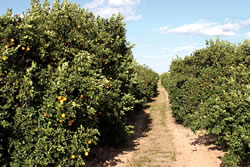BUSINESS
Inside SCV History
The Story of our Valley - Beginnings of a New Development
September, 2006 - Issue #23
 |
In the years following World War II, during which many a soldier passed through the Golden State either during training or on their way to deployment throughout the Pacific Theater, huge residential and industrial projects began all around Southern California. From 1950 through the early 1970s, the San Fernando Valley, which had been home to millions of citrus trees, was inundated with the construction of homes for nearly a million people. This vast development actually slowed the growth in Santa Clarita because there was already such availability within the same proximity. During this time, however, businesses clambered to the valley, noting that these new residents of San Fernando would much rather make the short trip north rather than the trek into Downtown Los Angeles. It would take a few more years and a new leading figure before the infrastructure, homes and people would descend into Santa Clarita.
| "Several studies had confirmed that there was potential for development, though each recommended that any homes or businesses be kept away from drilling operations, where it was assumed that the real profits lay." |
The building managed in Downtown San Francisco that had long been owned by White Investment was barely turning a profit. Rent prices hovered at 60 percent of comparable properties around the city. Going back on an old habit, McBean placed a call to Stanford Business School looking for top graduates. One of those just finishing was Jim Dickanson, a retired military officer and former small business owner. From the beginning, Dickanson and Scott Newhall, a grandson of Henry Mayo's, formed a deep friendship. Even at times when Dickanson may have been at odds with Atholl McBean, who was the company president, Newhall stuck by his side and worked through these difficulties. After significant early success with Dickanson in turning around the real estate in San Francisco, McBean asked Dickanson to work for him in Santa Clarita. Just married, Dickanson insisted on a salary of $450 a month and McBean agreed. The job would be short lived, however.
McBean had other loyalties at Stanford besides his business school recruits. The Stanford Research Institute (SRI) had been founded in large part with funding from Atholl. He had even convinced the Newhall company board to purchase two associate memberships. With development nearly assured in the future, McBean commissioned a study by the SRI to examine the feasibility of a city in Santa Clarita. The report seconded all those before it, saying that a master-planned community, located in the flat plains west of Newhall adjacent to the Santa Clara River, would be ideal for such a city. Forgetting about Dickanson, McBean followed the report to the letter, hiring William Rand, a long-time member of the SRI, as vice president for real estate. The Santa Clarita Valley would be changed forever.
--------------------------------------------------------------
Much of the research for this article came from "A California Legend: The Newhall Land and Farming Company" by Ruth Waldo Newhall.
|
||||||||||||||||||||||||||||




